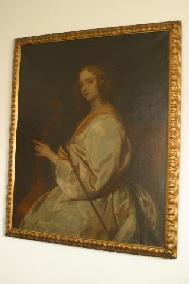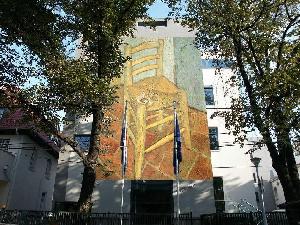Putting on de Stijl
It's an embassy, but not as we know it, as Michael Bird takes a peep
at the new Dutch administrative office in Bucharest
Breaking out of the traditional classical style of an embassy, the
Netherlands sought out a more modern and design-led environment to
represent its diplomatic community in
Romania.
“We had used the same embassy for
forty years, but since 1989 it has been a
different ball game and, as we were in the
process of doubling our personnel, we
were looking for more space,” says
Nienke Trooster, counsellor and deputy
head of mission at the Embassy of the
Kingdom of the Netherlands. “The
previous administration department was
in a very small space, in a basement, where the air wasn’t healthy, there were
small windows with bars and the heat
wasn’t regulated.”
Occupied by the Dutch embassy
since August 2004, the 900 sqm property
emphasises the importance of working in
a pleasant and harmonious environment
with plenty of natural light that allows
departments such as the consular,
economic and agriculture to carry out
their duties in an open and spacious
atmosphere.
A private house before 1950 the
Avaitorilor-based detached block on
Aleea Alexandru was then nationalised
and became a heavily-guarded secure
unit of the Ceausescu regime.
So additions were needed and Delftbased
design firm Cepezed built a glass
front around the consular department,
seeming to adopt, in a visual form, one of
the maxims of the European Union –
transparency matters.
Although at first glance the interiors
seem to offer a plain and clinical environment, on closer examination the
softness and calm of the office begins to
emerge, with an atmosphere more
reminiscent of the headquarters of an
architectural compound.
This includes grey cotton carpets,
black corduroy-backed office chairs
inspired by the De Stijl art movement,
manufactured by Dutch-based Gispen,
and low felt armchairs in grey and red,
following the designs of seating guru
Gerrit Reitveld. Every piece of furniture,
from the lamps to the tables, is designed
to be light and flexible, while retaining a
Dutch signature. “Even though it’s
functional, it can still be comfortable,”
addsTrooster.
The choice of paintings was
coordinated by the Netherlands
Department of Housing in the Ministry of
ForeignAffairs, which has a special team
of art specialists who are dedicated to
making the interiors of Government
representative offices around the world
more aesthetically pleasing. This
department supplies the embassy with a plan of the embassy and a list of
paintings, where and how to hang them.
But this is not an inventory of Dutch
cliches found in anAmsterdam gift shop -
tulips, windmills, canals and clogs are
nearly all absent - instead this is an
interior which celebrates the twentieth
century design heritage of the
Netherlands with a selection of prints
that showcase some of the latest talents
that Holland has to offer.
The art specialists even gave the
new embassy a list of themes - naivete,
colour and figurative art – to allow
consistency and a reaction to sitespecificity.
There are three different pictures of
Queen Beatrix – an official photograph, a
linear drawing from a bronze cast painted
by Jereon Henneman and an illustration
in which she appears throughout the red, white and blue colour scheme of the flag
by the Dutch painter Marte Röling.
 To bring contentment to the
traditionalists, a copy of the classic
portrait ‘Die Gambenspielerin’ by Van
Dijk hangs above the ambassador’s desk
and, when the Embassy opened, the staff
draped a massive print of Van Gogh’s
yellow chair from the roof, contrasting
the nation’s artistic heritage with its more
Modernist aspirations. One of the most
potent and unpretentious symbols of
Dutch art, the chair also managed to signify the fact that Holland then claimed
the seat to the six-month long presidency
of the European Union. To bring contentment to the
traditionalists, a copy of the classic
portrait ‘Die Gambenspielerin’ by Van
Dijk hangs above the ambassador’s desk
and, when the Embassy opened, the staff
draped a massive print of Van Gogh’s
yellow chair from the roof, contrasting
the nation’s artistic heritage with its more
Modernist aspirations. One of the most
potent and unpretentious symbols of
Dutch art, the chair also managed to signify the fact that Holland then claimed
the seat to the six-month long presidency
of the European Union.
But there are also more surrealistic
elements shown in Rob Sholte’s ‘Fairy
Tale’, a montage of a swan, in which
hands take the place of its beak and
wings. While abstract art is represented
by Cees Andriesse’s coloured paintings
that resemble details from an ink-blot
test, naïve art brings a more buoyant and
colourful aspect to the interiors, in Theo
Van de Goer’s modern illustrations of
fairy tales and Henrietta Boerendans’
paintings of rural scenery.
Together the interiors neither resort
to shock tactics nor rest upon the
aesthetics of a previous, lost period of
time, but gently lodge in the visitor’s
mind a sense of modern and mannered
talent at work.
Michael Bird |
|

